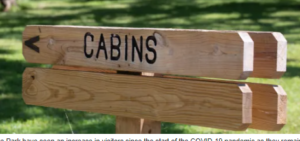Kansas is often maligned for what it does not have. The state has no mountains — unless Mount Sunflower in Wallace County tickles your fancy — and, with no large bodies of water, the amber waves of grain are the only you will see in Kansas.
But for Conner O’Flannagan, this misses the point.
As director of Clinton Lake State Park, O’Flannagan says he finds many residents don’t even know his slice of Kansas exists, even though it is just off Interstate 70 outside Lawrence.
“I think there’s a lot of natural beauty in Kansas,” he said. “People don’t think about it or maybe don’t even want to think about it. Yes, we’re a very flat state. But I go to our state parks and I see views that I don’t see anywhere else.”
While 2020 was a hard year for Kansans, the state park system was a silver lining for many who previously had never wandered into the great outdoors.
One of those is Kelleigh Lowe, who went to Clinton Lake frequently as a child but didn’t come back until the COVID-19 pandemic.
While she will bring her kids out to the park, it is also an opportunity for solitude.
“I’m coming up here for mom time,” she said.
Parks saw an unprecedented spike in interest during the pandemic, seeing visitor numbers hit historic highs in 2020.
But now the parks system, which spans 28 parks across Kansas, is faced with a new set of challenges.
Officials are now considering whether to upgrade facilities to cope with more visitors.
All the while, climate change is an ongoing threat facing ecosystems throughout Kansas, something that could alter what residents see when they head for the great outdoors.
And in the short term, parks want to keep residents coming back to better understand and appreciate the Kansas outdoors.
“These are important spaces,” said Linda Lanterman, state parks director. “I don’t know how a person could not have some green space in their life and be healthy. And I truly believe that we need these open spaces in Kansas. And I think they’ve shown to have a lot of value to us.”
The Kansas Department of Wildlife and Parks never formally closed the state parks during the pandemic.
This helped make 2020 the first time the system has surpassed 8 million visitors in a given year. While visitation slipped back to 7.6 million in 2021, it still was above average for the system, and 2022 is on pace to be more of the same.
The parks also capitalized on booming sales of RVs, increased interest in watersports, such as kayaking, and a demand for traditional, primitive campsites.
In some cases, this outstripped the parks’ ability to keep up, Lanterman said.
“When you have this happen to you, you can see pretty quickly, ‘Oh, we don’t have enough,’ ” she said.
Five years ago, Jamie Stokes and her husband elected to pull up stakes and move to a campsite at Clinton Lake in an RV after their kids left town.
She is now a volunteer at the park, cleaning cabins, among other tasks — but the couple has a bit more company than they used to. 
“They were kind of like, ‘Oh, we’re tired of being stuck in a house. We’ll go out and buy a camper,’ ” Stokes said of the people she would see coming and going at the campsite.
To O’Flannagan, this was a blessing and a curse.
The pandemic meant more visitors and thus more funds for the park but also fewer events and opportunities to connect with the people who were paying his 1,500-acre office a visit.
“We’re not really in the revenue business. We’re in the memory business,” he said.
Unlike other states, the state park system is almost entirely funded based off user fees, meaning no state tax revenue is diverted to pay for operations.
At Clinton Lake, the surge in demand has prompted some changes. The park cabins were refurbished, for instance, to help improve their appearance and make them easier to clean.
The burst of visitors meant even O’Flannagan and his deputy were cleaning the cabins at times.
But even still, he cautioned the park had to be careful in expanding campsites or making other moves in a bid to capture the increased interest for fear of ruining the reason people want to come to the park in the first place.
“Clearly, we need to make revenue to operate. We also need to have those outdoor experiences still available,” O’Flannagan said. “The last thing I’d want to do is have someone come into the state park and it’s nothing but camping. Although camping drives our revenue and drives how we’re able to operate, we still need to have those outdoor recreation amenities that are still there.”
Few travelers go out of their way to visit central Kansas. But a four-county swath of the state near Great Bend is immensely popular with a particular kind of voyager: shorebirds, who flock to Quivira National Wildlife Refuge and Cheyenne Bottoms Wildlife Area as part of their annual migration.
“People when they see the wetland, they just think it’s a big pool of water,” said Mike Oldham, director of Quivira National Wildlife Refuge, which is run by the U.S. Fish and Wildlife Service. “But there’s more to it than that.”
The slightly salty water makes an ideal spot for the birds and makes it unique among Kansas wetlands.
An estimated 45% of the North American shorebird population stops at Cheyenne Bottoms, which along with Quivira has been designated a Wetland of International Importance.
A stream of tourists usually flocks to the region, following the birds.
Curtis Wolf, director of the Kansas Wetlands Education Center, which is located at Cheyenne Bottoms, said the most recent spring was an unusually fruitful one for both bird and human visitors.
Travelers from 30 states stopped by and, in recent months, there has also been a noticeable uptick in bird-watching more broadly, Wolf added.
“We get a lot more questions about purchasing a pair of binoculars or what field guide they need to need to get — that sort of thing,” he said.
Whether people and birds will come in the fall, however, is unclear.
Like much of western Kansas, rainfall has been unusually scarce in Cheyenne Bottoms. The wetlands are “dirt dry,” Wolf said, and unless that changes, birds will likely be forced to go elsewhere.
“If we stay at where we’re at over the next two months, without much rain at all, we’re not going to have a fall migration,” he said.
Rainfall can be cyclical in the region, but there is also a sense that climate change is at play.
Nationally, public lands are at a higher risk of climate change-related impact. A 2018 study found many of the country’s national parks had seen higher temperatures and lower rainfall than other parts of the U.S.
Prior to the COVID-19 pandemic, 2020 was already a challenging year for the state parks system, as it was coping with historic 2019 flooding at many of its sites that was scarcely dealt with before the pandemic hit in full force.
At Cheyenne Bottoms, the park is years into a renovation to improve the park’s infrastructure and counteract ecological issues, notably a buildup of silt. This is a problem as it clogs drainage ditches and allows invasive species to flourish.
But Wolf noted he was unaware of any specific efforts to research and understand the specific impacts climate change might have on the area.
“It’s definitely something that needs to be looked at,” he said.
State park officials say they are looking to keep building on the pandemic-induced visitation spike.
Programming, such as nature walks or music in the parks, has started back up. The system is a partner with the Sunflower Summer program from the Kansas State Department of Education, allowing kids on summer vacation to camp for free in the park on certain days.
And the state has rolled out a new initiative, where those interested in visiting the parks can check them out — literally — by obtaining a permit from their local library.
“I don’t think we can sit back on our laurels and not do anything,” said Lanterman, the state parks director. “I don’t think we can take it for granted. I think we have to continue to be better.”
There are some, however, who say one way for the state parks system to improve is for there to be more of it.
Kansas ranks last in the country for the percentage of its territory controlled by the federal or state government. When accounting for just state parkland, it fares slightly better, ranking 42nd nationally.
This is, in large part, a quirk of history: Land was parceled out to homesteaders and farmers in Kansas right as the conservation movement was beginning to take shape. And the wide-open land of the Sunflower State made granting settlers land a viable tactic; the terrain of the Rocky Mountains, however, did not.
That isn’t to say there isn’t some element of public-private partnership in Kansas.
Farmers often use the Conservation Relief Program, which pays them to take the land out of use and plant native glasses or install wetlands. And the KDWP will partner with private landowners to allow hunting and fishing on their property.
But it isn’t quite the same.
“I might have something in Conservation Reserve Program for a little while,” said Zach Pistora, a lobbyist for the Sierra Club. “And then prices change and I think I want to take that land and put it into production. And so then that could potentially change the conservation dynamics as well.”
Pistora argued the state should do more to help outdoor enthusiasts and private landholders alike, such as cutting property owners a break if they grant an easement to allow public use of rivers.
While the Kansas, Missouri and Arkansas rivers are navigable, most others in the state aren’t because they fall on private land.
The goal, Pistora said, should be to build toward allowing for as broad of an understanding and respect for natural spaces as possible.
“For a state that has as many acres as we do in Kansas, a lot of incredible features, right — we have beautiful Flint Hills, a lot of different geological formations, different areas of the state which provide different ecosystems,” Pistora said.
“But not everybody is able to interact with that,” he added. “And without that physical enjoyment and connection to the land … we haven’t fully developed the appreciation and value of the land that it could provide.”
Stokes, the Clinton Lake volunteer who lives at the park with her husband, said her appreciation for the space has grown while living there full time.
While most couldn’t imagine camping in such a setting year-round, she said there is no place she’d rather be.
“It is the most peaceful place ever,” she said. “The birds are always chirping. Most of the time the sun is shining. The wildlife is amazing.”
As reported in the Topeka Capital Journal


